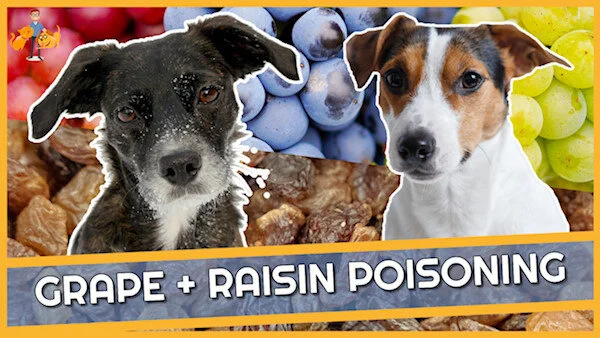Raisin + Grape Poisoning in Dogs - How Many Will Kill?
Our Pet’s Health is community-supported. When you buy through links on my site, I may earn a small commission at no additional cost to you (learn more). That said, I only recommend products I believe in, thanks!
Has your dog eaten some grapes or raisins and you want to know how many are poisonous and if you should be worried or not?
Have you heard conflicting stories about whether grapes are poisonous for dogs or actually completely safe?
In this comprehensive article, I’ll break down why you need to be careful with your dog eating grapes and raisins, how many can be dangerous, and clear up any confusion you may have about conflicting reports.
Let’s jump straight into the big question...
Are Grapes and Raisins Toxic to Dogs?
The simple answer is that yes, both raisins and grapes have the potential to be poisonous to dogs.
They can be so toxic that a dog might only need to eat a few to suffer from fatal kidney failure as a result of poisoning. There is no doubt about it, dogs can and do die after eating raisins and grapes.
There are two problems with this statement, however. The first is that no one knows exactly what it is in the grape that results in poisoning.
The second is that not every individual dog is equally sensitive to this unknown toxin.
Recent research may resolve these problems with recent promising work investigation why grapes are toxic to dogs which I discuss further down the page.
How Many Grapes and Raisins Will Kill a Dog?
The following grape and raisin poisoning calculator will let you know the number of each that needs to be eaten by your dog to have the potential of being poisoned.
All you need is their weight.
Keep reading though as the answer may not be quite as black and white as you would hope:
GRAPE Toxicity Calculator
(calculator can take a few seconds to load)
INDIVIDUAL SENSITIVITY
There have been reports of some dogs eating only a small handful of grapes before then showing signs of poisoning. Other dogs have eaten a bellyful and suffered no ill consequences.
There is a huge range of either individual dog sensitivity to the toxin, or differing toxicity of the grapes and raisins themselves.
The lowest reported toxic dose for raisins is 0.04oz per pound (2.8g per kg), and for grapes, the lowest reported toxic dose is 0.32 oz per pound (19.6g per kg) body weight.
Using this toxic dose would mean that a 10 pound (4.5kg) dog could be poisoned by as little as 17 grapes or 11 raisins. A 40 pound (18kg) dog, on the other hand, would need to eat 68 grapes or 44 raisins.
While that may sound like a lot, just count how many grapes are on the next bunch you bring home from the supermarket, or how many raisins you put in your next fruit cake.
To complicate matters even further, there are also reports of an 18lb (8.2kg) dog dying after eating only 4-5 grapes.
This is much less than the 30 grapes suggested by the lowest toxic dose.
The bottom line is that we don't know how many grapes or raisins will kill an individual dog. For some, it may be a very small number, while others may eat a much larger amount and be completely fine.
The only way to know would be to let your dog eat some and watch what happens. Obviously not something I'd recommend, and even then a different type of grape may give a different result!
ARE GRAPES POISONOUS TO CATS?
Grapes and raisins are also poisonous to cats.
Cats though are generally a bit more selective as to what they eat and so it's not a problem we often see in the veterinary clinic.
Why Are Grapes And Raisins Poisonous?
Grape and raisin toxicity has been a recognized problem for well over 20 years. But up until recently, the big mystery has been why.
Recent evidence suggests that it is the presence of tartaric acid and potassium bitartrate (aka Cream Of Tartar) in grapes and raisins that results in the potentially deadly kidney damage seen in cases of poisoning.
This potential breakthrough came when veterinarians at the ASPCA Animal Poison Control Center noticed the similarity between a case of homemade low-salt playdough poisoning and that normally seen in cases of grape toxicity.
And as for why some dogs develop poisoning and others are completely fine after eating grapes or raisins - it is well known by the wine industry that tartaric acid levels in grapes vary in concentration with type, growing conditions, and degree of ripeness.
There may be no variation in individual dog sensitivity, but instead a variation in individual grape toxicity.
This information also highlights the fact that baking (or other food products) containing cream of tartar should never be fed to your dog, and great care is needed to restrict their access to these products.
As already mentioned, this also includes homemade playdough (the high salt content making this doubly dangerous), as well as the African fruit Tamarind.
Watch this space for even more clarity as more work is done in this area which will hopefully help predict the potential for poisoning as well as lead to more effective treatment options should poisoning occur.
Poisoning Prognosis
For those dogs that are poisoned by raisins and grapes, kidney damage takes place and, depending on severity, a dog can go on to develop life-threatening acute kidney failure.
If caught early this kidney damage may be reversible and a full recovery can be made. The longer the damage is left untreated, however, the harder and more unlikely this recovery will become.
If left too long, or if the level of toxicity is too great, it may be the case that no amount of treatment will be able to stop a dog from dying, regardless of how quickly the treatment is started or how aggressively it is pursued.
TREATING GRAPE AND RAISIN POISONING
If you get your dog to the vet within a couple of hours of eating the raisins or grapes, then the first step in their treatment is likely to be making them vomit.
This will remove any that are still present in their stomach.
Activated charcoal and laxatives may then be given to try and bind any toxin, keeping it within the intestines rather than being absorbed, and to encourage the intestinal contents to more rapidly pass out of the body.
Intravenous fluid therapy will also be started to maintain hydration and ensure that the blood supply to the kidneys is optimized.
During this time, your dog will be monitored closely for any change in their condition, and to ensure that they are producing a good amount of urine. Acute kidney failure can lead to a complete loss of urine production - a development that carries a very poor prognosis.
The level of treatment and monitoring needed will vary depending on your dog’s medical history, the amount eaten, and whether vomiting was successful.
Finally, blood testing will be carried out to more closely monitor for signs of renal stress and overt kidney damage. In mild cases of poisoning, a single blood test may be all that is needed. In other dogs, multiple tests may be run every day for the entire period of hospitalization.
If your pet is AOK after 24-48 hours then they will be given the all-clear!
What to Do if Your Dog Eats Grapes or Raisins
All this uncertainty about grape and raisin poisoning presents a real problem when it comes to deciding what to do if your dog consumes either grapes or raisins.
Some pet owners will be happy to just watch their dog and seek veterinary treatment if they show any signs of poisoning - such as vomiting, diarrhea, pain, weakness, wobbliness, or inappetence.
The clear problem with this approach though is that by the time a dog is showing signs of grape poisoning, the damage to their kidneys may already have become irreversible.
Treatment may not be able to save them where, had treatment been started earlier, they may have been back to normal only a few days later.
Because the consequences are so severe, I would recommend a much more risk-averse approach:
If your dog has eaten more grapes or raisins than the lowest reported toxic dose (or you do not know how many they have eaten), then taking your dog to the veterinarian for emergency treatment is the safest course of action.
If your dog has eaten less than this amount, calling your vet is still a good idea as there may be individual concerns or precautions you need to take for your individual dog (for example if they are very young or already suffering from chronic kidney disease).
Preventing Poisoning
Prevention is always better than rushing your dog to the emergency veterinarian.
Keep any fruit cake in a high cupboard, make sure the fruit bowl is out of reach, and don't ever be tempted to give your dog anything with raisins or grapes in it.
Christmas and Easter are times when you need to be extra careful with the ready availability of mince pies, hot cross buns, and other seasonal delicacies!
Preventing disease and taking active steps to keep your dog as healthy as possible is something I strongly feel every pet owner should focus on. Not only can this prevent emergencies, but being proactive will also help keep your dog as happy and healthy as possible well into their old age.
It is for this reason I wrote my FREE 5-step guide to keep your pet happy, healthy (and out of the vet clinic)! Download your free copy here.
Related Posts:
How much chocolate will kill a dog (with toxicity calculator)
The 20 everyday poisons in the house and garden every pet owner should know about




